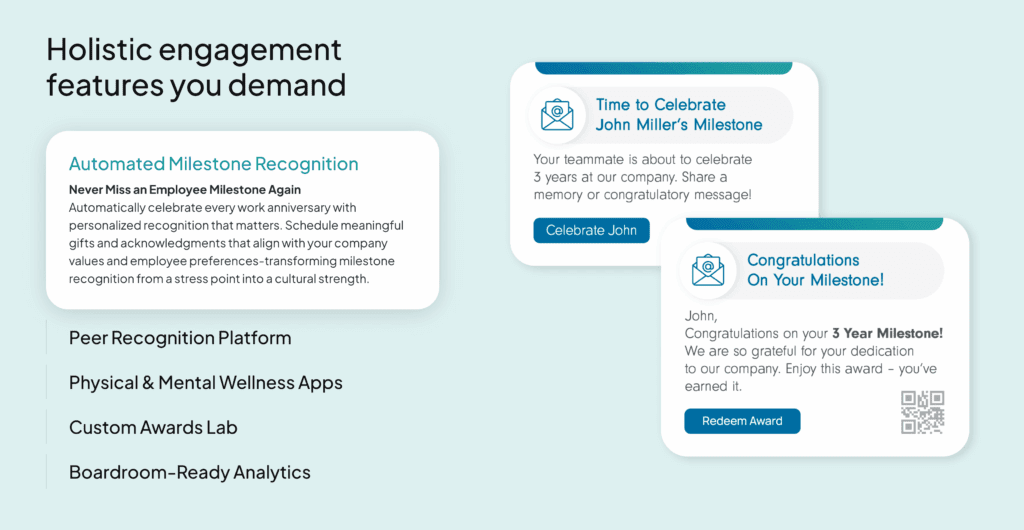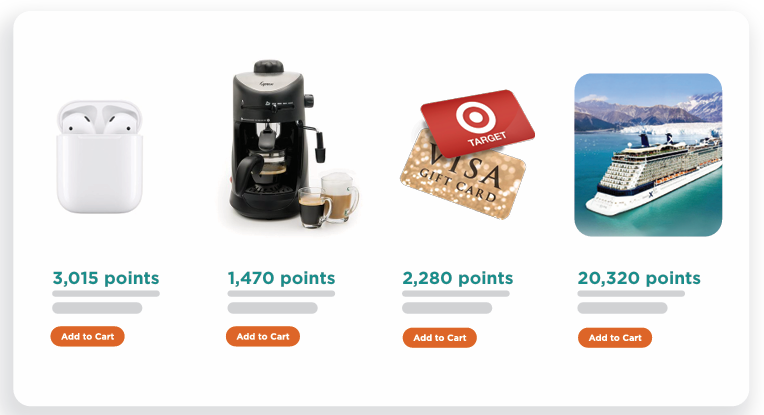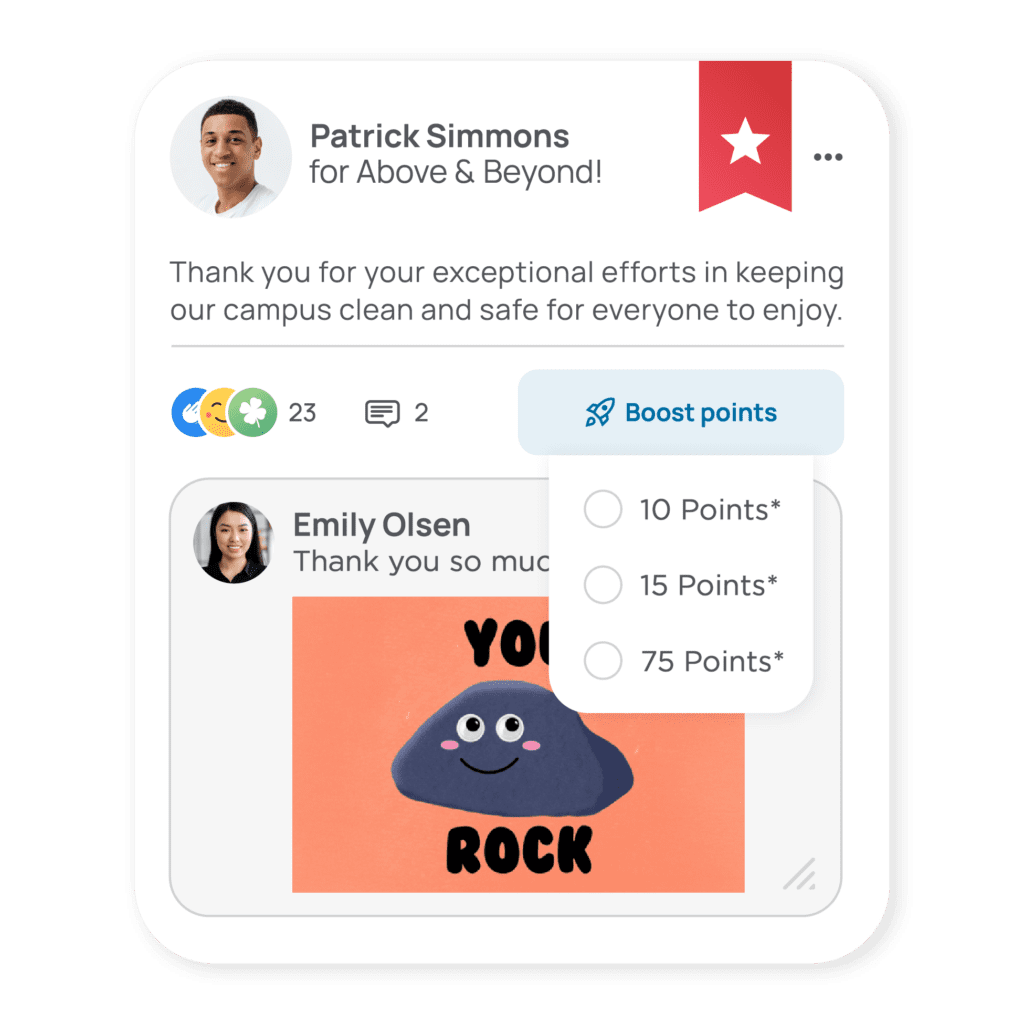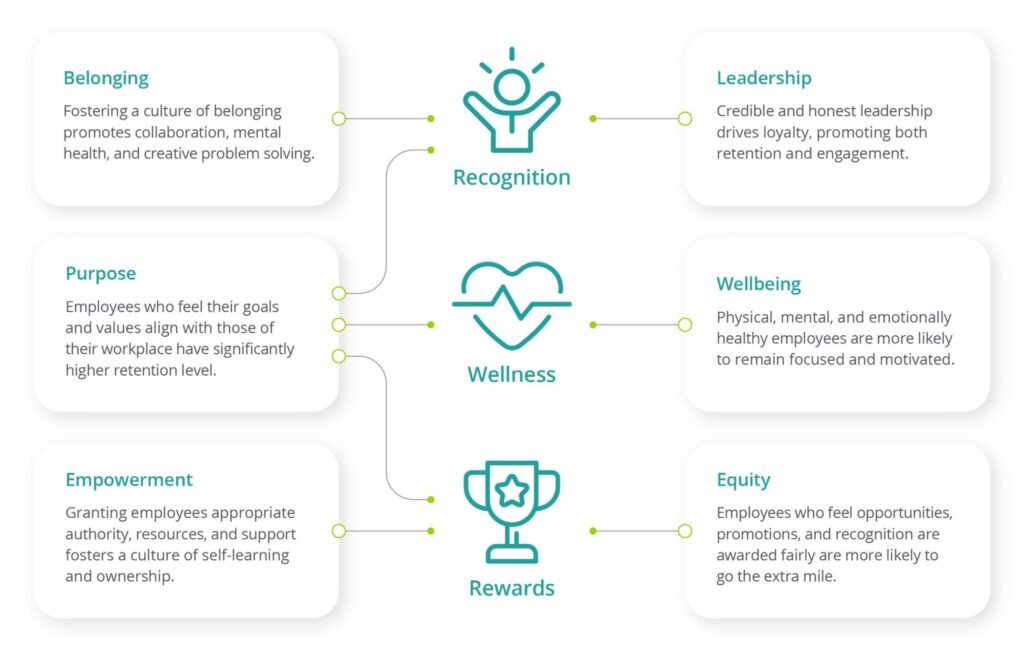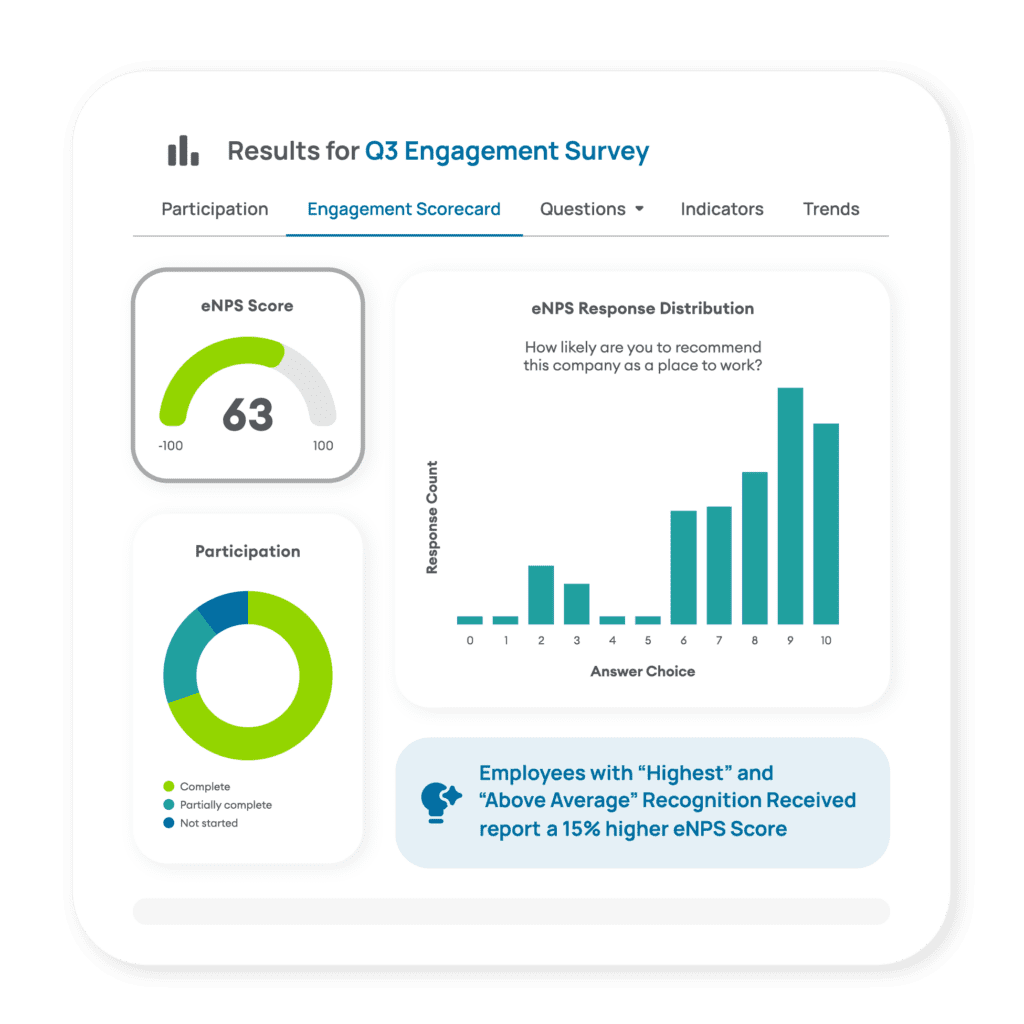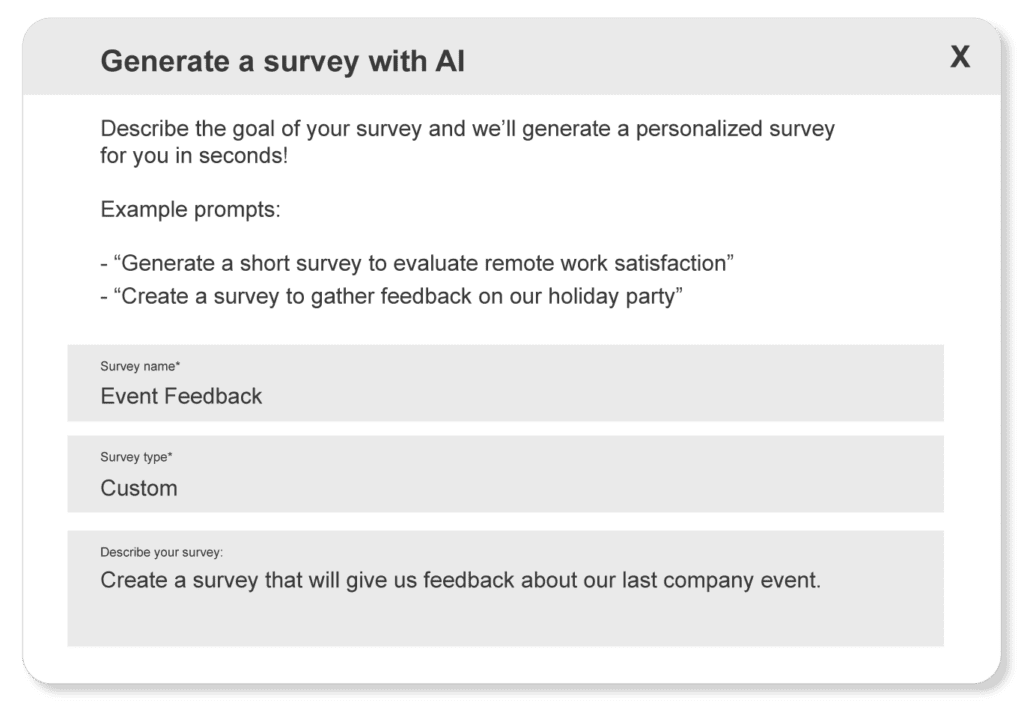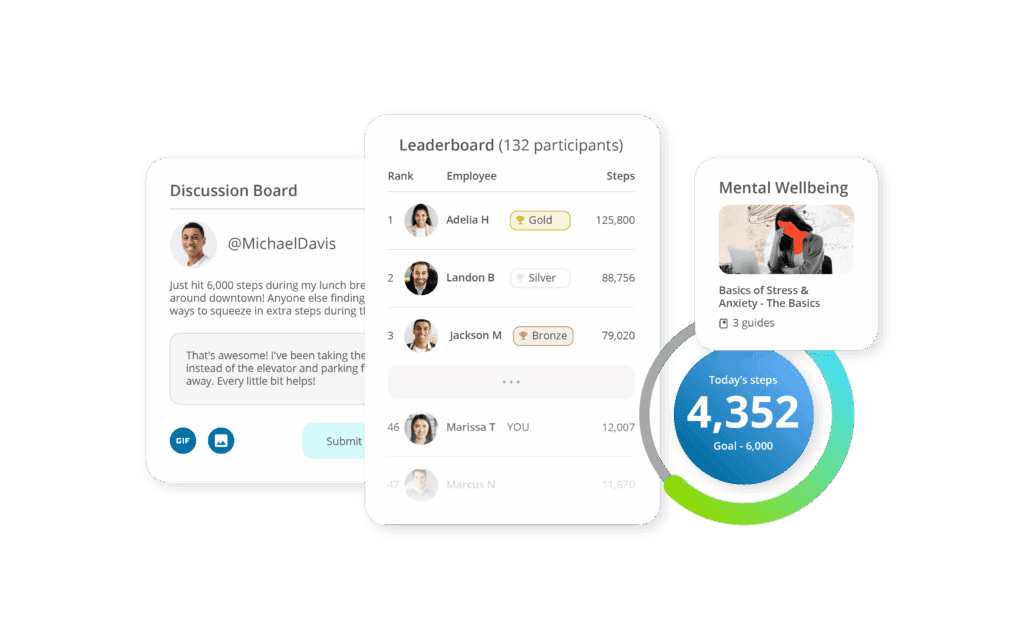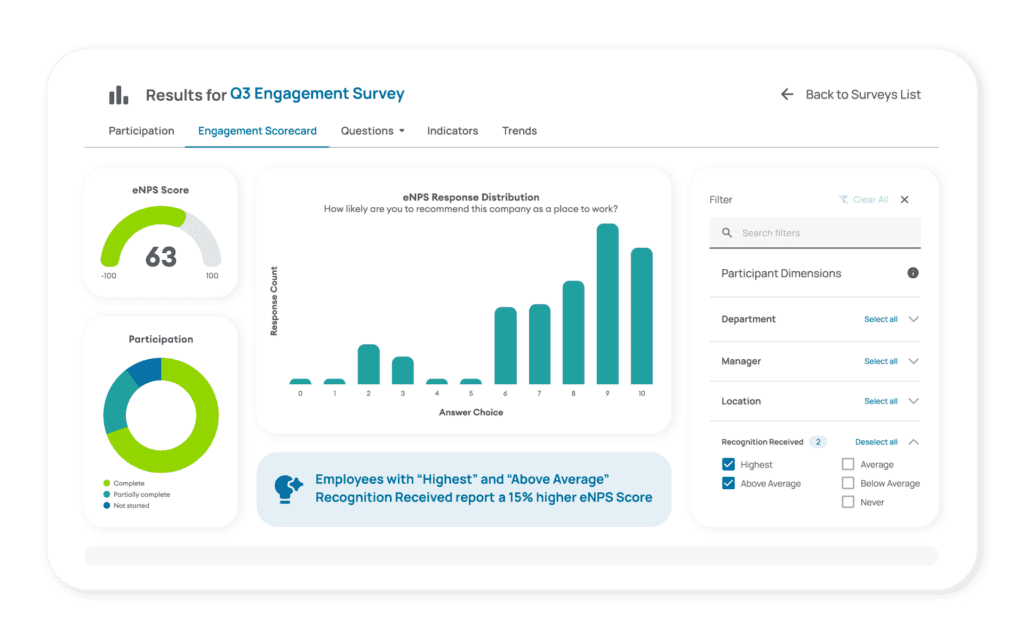November 12, 2025

The retail industry’s exceptionally high turnover rates are a symptom of the industry’s broader challenges with keeping employees engaged. Employee engagement tools can uncover the factors impacting engagement in your company specifically and help you address them with tailored programs. However, these programs need to support your retail organization’s unique setup and working environment.
If you plan to invest in employee engagement tools for retail, it’s important to choose platforms that:
- Support frontline workers: These platforms bring your engagement programs directly to workers, e.g., via mobile app, integrations with your communication tools, and offline participation options such as code-based rewards redemptions, paper-based surveys, and presentation kits.
- Empower managers: Manager involvement is a key success factor for employee engagement programs. Check for tools that help managers engage their teams (e.g., with on-the-spot recognition), automate approvals and repetitive workflows, and provide insights into budgets, team engagement & participation.
- Can be configured to your strategic objectives and workforce setup: Does the platform configure programs to your business goals, such as promoting core values, rewarding top performers, or encouraging workers to follow safety protocols? Can you tailor programs to specific groups—e.g., customer feedback recognition programs for your customer service reps?
- Provide the data you need to take action: Prioritize platforms that offer more than basic participation data. Does the tool combine data across your different engagement programs? Can you analyze engagement across different cohorts using filters (e.g., for departments, age groups, job titles, levels of seniority, tenure, etc.)
- Centralize expenditures to help you track budgets: It’s common for retail teams to spend on informal engagement initiatives—e.g., managers handing out gift cards or hosting team-building competitions with rewards. These budgets aren’t properly tracked, leaving organizations with unchecked “ghost” spend. Employee engagement tools with integrated rewards systems track these expenditures and display how allocated budgets are being used.
In this article, we explore the different types of retail employee engagement tools for designing and scaling programs tailored to your strategic objectives.
In a Hurry? Here Are The Top 5 Tools We’ve Selected
- Terryberry: Our integrated engagement platform combines four tools—employee listening, recognition, rewards, and wellness solutions. It gives retailers everything they need to measure, quantify, and drive engagement in one centralized platform. Over 40,000 organizations use Terryberry to boost engagement and retention, including Tesco, The Co-op, and Discount Tire. It helps address:
- Organization-wide needs—making employees feel heard, recognized, and supported.
- Cohort-specific gaps—e.g., new hire turnover or frontline manager burnout.
- SafetyCulture: An engagement app that focuses on empowering frontline retail workers with compliance training & tools. SafetyCulture also digitizes company training courses and standard assessments, and helps communicate changes to operating procedures.
- Totara: A highly customizable employee learning management system (eLMS) that helps organizations identify skills gaps, provide tailored training, and track skills progression and competency. It’s used by retail organizations like Lidl.
- Beekeeper: A frontline employee engagement and communication app. You can use it to schedule shifts, share real-time updates in multiple languages, and automatically answer payroll inquiries.
- Kenjo: A workforce management system that supports retail organizations with recruiting, onboarding, shift scheduling, leave management, time tracking, and performance management.
Interested in seeing Terryberry in action? Request your free live demo.
1. Terryberry’s Full Suite of Employee Engagement Tools for Retail
Terryberry’s suite of engagement tools empowers retailers to address their most pressing challenges in employee engagement, from fighting manager burnout and frontline turnover to aligning their large, distributed teams around shared values and objectives.
- Capture employee feedback and benchmark employee engagement & retention. Terryberry’s employee listening tool includes dozens of pre-designed surveys, including employee satisfaction, pulse, eNPS, science-backed engagement surveys, and many more. You can measure and quantify the factors impacting engagement—informing your broader engagement strategy—and administer surveys on autopilot.
- Configure engagement programs to your strategic objectives. We’ll configure Terryberry to support the type of program you choose, and customize specifics such as nomination workflows, incentives, gamification, and recognition moments. You can launch programs to promote core values, support employee well-being, incentivize performance (e.g., not missing a shift or exceeding their sales quotas), and more.
- Make programs easily accessible. We bring your programs directly to your frontline workforce via a mobile app and integrations with MS Teams and Outlook. You can also select password-less login options and choose from various offline participation options (code-based redemptions, offline presentations, paper-based surveys, and more).
- Support microcultures. Different groups of employees often form their own microcultures: maybe the warehouse team likes to celebrate “zero accident” days or one branch’s floor workers have a high-five wall on a bulletin board to celebrate teamwork. We’ll help configure your programs to support these microcultures (e.g., by incorporating offline recognition and reward options or bringing peer recognition to a kiosk)
- Empower managers with engagement tools and automated workflows. Terryberry supports managers with:
- Automated alerts, reminders, and approval workflows.
- Hassle-free options to reward and recognize employees.
- Real-time visibility into how they’ve spent their allocated budgets.
- Insights into their team’s engagement.
- Measure impact with deep, centralized analytics. Terryberry aggregates the data across all your engagement programs to help you:
- Measure their impact on employee engagement, retention, and each other.
- Uncover gaps that affect specific groups (e.g., whole departments, employees with shared tenure, floor managers, top performers).
- Track budgets and expenditures across all programs.
Up next, we’ll discuss how to:
- Design tailored programs with Terryberry that bring teams together, drive engagement, and boost retention.
- Measure and quantify employee engagement in your organization with our science-backed culture model—and how to scale a continuous employee listening program with automation.
- Proactively support your team’s well-being with tailored wellness initiatives.
- Build a business case for your engagement program with Terryberry’s centralized analytics.
Employee Recognition: Launch Custom Programs Tailored to Your Strategic Objectives
Terryberry’s employee recognition software lets you design and scale programs tailored to specific objectives, including years of service, safety, Employee of the Month, customer feedback, and more. You can configure:
Program objectives, nomination workflows, and approvals
Terryberry ties programs to objectives by customizing nomination and approval workflows and creating milestones. You can use these features to design the type of goal-driven programs we discussed earlier—ones that recognize individuals for following safety protocols, supporting their peers, and service anniversaries, among other accomplishments.
You can also specify who can nominate and reward people. For example, you can allocate budgets to managers for on-the-spot recognition, allow workers to recognize their peers, and create nomination panels that require final approvals from senior leadership.
How employees receive their rewards
Terryberry’s integrated rewards platform offers:
- Custom awards: For over 100 years, we’ve been manufacturing awards, including trophies, plaques, and jewelry.
- A customizable rewards catalog: Terryberry’s Premium Rewards catalog features various rewards categories, including electronics, travel, lifestyle, top-brand merchandise, once-in-a-lifetime experiences, charitable donations, and more. You can mix and match these categories to create a custom shopping portal for your teams.
- The largest selection of rewards in the market via Amazon Business: Unlock zero-markup rewards and get Prime-like delivery across the U.S. thanks to Terryberry’s integration with Amazon Business (U.S.).
Terryberry brings Premium Rewards—without the expensive shipping fees—to teams across 100+ countries via partnerships with local fulfillment partners.
Our rewards platform also lets you customize how people are rewarded, using:
- The points system: The points system allows you to reward people more for certain goals or milestones than others. For example, you might allocate 20 points to someone the first time they demonstrate a core value, and 50 points for the tenth time. Or, maybe you award a different number of points for following incident control protocols and picking up extra shifts, respectively. You can also allocate a points budget for managers to spend at their discretion, and allow peers to “boost” recognition moments by awarding the recipient more points.
- Recognition levels: You can customize different recognition levels that correspond to respective budgets—e.g., receiving recognition at level 3 means you can purchase rewards worth $100, while level 4 takes you up to the $150 rewards tier. Retail companies typically use the recognition levels system for years-of-service awards programs—employees unlock successively higher reward tiers as their tenure increases.
1. Manager Recognition Programs: Empower Managers to Engage Their Teams
Industry research highlights the importance of manager involvement in engaging frontline teams, including those in retail. We’ve seen this time and again for ourselves—for example, the results from the Co-op’s employee listening program revealed that frontline workers valued meaningful recognition from their managers.
Terryberry lets you allocate budgets to managers, allowing them to engage their team members in different ways. For example, frontline managers can:
- Recognize employees on the spot for taking up extra shifts, demonstrating core values, or going above and beyond to support a customer.
- Award points for performance outcomes—for example, if a sales rep exceeds their daily upsells quota or a service rep receives outstanding customer feedback. They can also reward their whole team for collective victories—e.g., if the warehouse day goes a full day without any accidents.
Managers can broadcast these recognition moments and team wins for your whole organization to see, using the culture hub. Terryberry’s dashboards also let managers keep track of:
- Budgets: including the number of awarded, remaining, and expired points.
- Team recognition: including your most and least recognized employees and top reasons for recognition.
2. Milestone Recognition Programs: Increase Retention and Loyalty
Celebrate people’s personal and professional achievements—such as birthdays, work anniversaries, sales performance, or achieving safety records—by launching customized milestone recognition programs.
Long- and short-service award programs are particularly effective in driving retention. For example, we’ve helped organizations increase tenure with service anniversaries. The Co-op partnered with us to launch a program celebrating its 70,000+ staff members from their first anniversary through to 15+ years of service. The retail chain’s program celebrates around 10,000 employees annually, boosting morale and long-term retention.
While a years-of-service awards program can help you increase employees’ overall tenure, industries like retail suffer from high first-year turnover rates—meaning you’ve got to consistently engage them before the first-year mark.
We’ve designed custom new hire milestone programs that have reduced frontline employee turnover by up to 50%.
The key is to gradually integrate new hires into your company culture, while celebrating small victories along the way—on their first day, week, month, quarter, half-year, and year. For example, you might celebrate the completion of their onboarding process at the 1-month mark by publicly recognizing one of their main achievements—such as going above and beyond to help a customer.
Terryberry supports different types of milestone programs (including performance-based), such as:
- Monthly, quarterly, or annual “best sales rep” and “best customer service rep” awards—where you recognize top performers based on metrics such as their sales quotas and customer satisfaction scores (CSAT)/Net Promoter Scores (NPS).
- Tiered safety programs—where you celebrate the entire team for a milestone such as a “zero injury year,” or “no accidents quarter,” while further rewarding individuals who received the most recognition for following safety protocols throughout the year.
- Learning and development milestones—celebrating employees for completing advanced training and upskilling programs.
3. Peer Recognition: Empower Regular Employees To Drive Engagement
Peer recognition programs empower regular employees to champion your engagement initiatives—they can nominate colleagues for awards and recognize their contributions on the spot. For example:
- Floor staff can recognize each other for covering shifts or helping them out in peak-hour rush.
- Warehouse workers can recognize other teams for helping them cover an extra zone during peak hours or completing a truck unload ahead of schedule.
We’ll help you customize each program’s goals, design, and delivery to suit your organization’s broader culture and any microcultures specific to different branches, departments, or teams.
For example, maybe one branch uses a bulletin board for shoutouts and displaying the “employee of the month.” We can support these recognition moments with offline presentation kits and code-based rewards redemptions.
You can also broadcast achievements such as “employee of the month” in Terryberry’s shared culture hub for your entire organization to see. The culture hub lets peers nominate and recognize each other in a shared space, connecting teams across departments and branches that would otherwise have limited interaction.
For example,
- Sales reps can see stockroom workers recognize warehouse teams for helping them unload and store goods ahead of schedule. They can see the behind-the-scenes teamwork that brings the inventory to store shelves.
- Employees across different branches can view the contributions and achievements of workers at various locations, fostering a shared sense of purpose.
Terryberry’s recognition software also supports nomination-based programs, where peers and managers can recommend colleagues for custom awards, such as “Team MVP” and “Cashier of the Month/Quarter.” Using Terryberry’s recognition software, you can configure:
- Nomination—such as requiring people to specify why they’re nominating someone, and specifying a minimum number of required nominations to be eligible for the award.
- Approval—for example, maybe some awards require a senior manager to approve the final section.
Employee Listening: Make Workers Feel Heard and Quantify Employee Engagement
Terryberry’s employee listening tool lets you capture regular, consistent feedback from employees, quantify engagement, and predict which groups are most likely to churn (and why). Our survey library includes dozens of ready-made employee surveys that you can administer via the Terryberry mobile app, kiosk, QR-codes and links, or on paper.
Here’s how you can track employee sentiments and uncover actionable insights with our listening tool.
Informing Your Engagement Strategy with Our Science-Backed Culture Model
Our listening tool’s library includes science-backed engagement surveys for measuring and quantifying your culture’s impact on employee engagement. These surveys are based on Terryberry’s culture model—which we developed with the help of three independent PhD researchers.
The culture model identifies six engagement indicators—belonging, leadership, equity, purpose, empowerment, and well-being—that predict engagement and retention. For example, employees who score high in purpose and well-being are typically more motivated at work and more likely to stay.
Our engagement baseline survey—designed by PhD researchers and backed by I/O psychologists—quantifies these factors using Likert scores. For example, a score of +20 in “belonging” suggests employees are strongly connected to your culture. In contrast, a score of -10 in well-being can signal that employees are struggling with their mental, physical, or emotional well-being, which can fuel fatigue and burnout.
As the name suggests, the baseline survey’s results serve as a reference point that reflects the current state of engagement within your organization. These insights reveal where your culture is strong and which gaps need addressing, as well as where you should drill down further.
For example, if you uncover low well-being scores, the next step is to understand why employees have these sentiments—are they experiencing fatigue or burnout? Are hectic shifts the cause? How can you support them?
As we discussed earlier, employees across different groups have different motivations, sentiments, and microcultures. So, while the baseline survey’s high-level results provide an overview of your workforce’s collective sentiments, it’s important to dig deeper using Terryberry’s survey analytics.
Terryberry’s analytics dashboard displays automated, high-level insights from your engagement results—including your best and lowest engagement indicator scores and benchmarks of your retention (eNPS scores) against those of similar companies (by size, industry, and size + industry).
Then, you can analyze engagement across specific cohorts using our participant filters for age, department, job title, location, manager (i.e., the teams under them), tenure, seniority level, and more. We also feed insights from your other programs into the survey analytics dashboard—e.g., you can filter survey responses by “most recognized” or “least recognized” employees.
Cohort analysis informs your broader engagement strategy by uncovering the needs of different groups, which you can address with tailored programs. For example, maybe you analyze the sentiments of floor managers across different branches and discover they’re scoring low in eNPS, well-being, and empowerment.
These results suggest managers are struggling with their physical and/or mental well-being and not feeling adequately supported in their roles—negatively impacting retention.
You can conduct additional surveys—including employee satisfaction, engagement, drill-down and burnout surveys—to identify the root causes. Maybe you’ll find that managers need more time off, additional training, and mental health support. Similarly, let’s say your baseline survey reveals low employee well-being scores for one of your departments. Burnout, job satisfaction, and drill-down surveys can help you investigate the root cause(s).
Using different participant filters and combining insights from various surveys provides deeper insights into the sentiments of different groups. For example,
- Comparing engagement indicator scores of groups with the lowest eNPS, to understand why they’re at risk of churn.
- Comparing eNPS and engagement indicator scores for employees with different tenures (e.g., 1,3,5,10,15) can help you (1) track the relationship between tenure and churn, and (2) identify which type of support employees need across the years.
- Compare engagement indicator scores for employees across departments and branches.
You can add more context to your findings using additional surveys. For example, eNPS surveys can help you identify which engagement indicators are contributing to voluntary employee turnover. After conducting eNPS and baseline surveys, you can find the culprit by checking which engagement indicator scores are negative for groups with low eNPS.
| Run Employee Listening Programs on Autopilot with Terryberry
Terryberry’s employee listening software includes various automation tools to help you administer surveys, process their results, and follow up to capture more context, including:
A $3 billion heavy equipment company used Terryberry to collect feedback from workers across over 100 locations and process the results. Terryberry’s employee listening software reduced the company’s survey processing times from several weeks/months to just a few hours—empowering managers to quickly take action. |
Employee Wellness Programs: Proactively Support Employees’ Physical & Mental Well-being
Frontline workers in retail—especially managers—are statistically more prone to burnout. Your employee listening program can help you identify the groups that require the most support and each one’s respective challenges. For example, maybe:
- Shift scheduling issues are fueling fatigue among frontline workers.
- Warehouse workers struggle with poor sleep cycles and dehydration.
- Frontline managers are stressed because they’re overwhelmed by their responsibilities.
You might consider several different courses of action to address these gaps. For example, you might provide existing managers with additional training, but also revisit the criteria for hiring/promoting people into managerial positions.
While our wellness platform lets you launch initiatives to address specific gaps—e.g., improving sleep, hydration, or work-life balance—it’s designed to uplift engaged employees by consistently supporting their physical, mental, and workplace well-being. In other words, it proactively addresses employee well-being, reducing the risk of fatigue and burnout across your organization.
Be Well offers various tools for supporting well-being, including:
- Gamified challenges—including step and activity, hydration, heart rate, and sleep challenges—or create custom challenges tailored to specific wellness goals. Be Well motivates teams to build healthy habits together, featuring leaderboards, custom incentives, in-app discussion options, and personalized performance metrics.
- Personalized well-being plans—tailored to each worker’s specific needs, such as reducing stress, learning to advocate for themselves, or taking the necessary steps to reduce fatigue and burnout.
- Expert-led wellness trainings. Terryberry’s wellness library offers over 150 on-demand audio guides across 40+ mental health topics. We’ll also help you schedule expert-led trainings to support workers with any persistent well-being challenges they’re facing.
- Detailed analytics. Use Terryberry’s Wellness Analytics to track employee participation, monitor progress across different challenges, and analyze the impact of your programs on recognition, engagement, and retention.
Measure Your Programs’ Impact and Uncover Gaps With Terryberry’s Centralized Analytics
Terryberry’s centralized analytics dashboards help you quantify the impact of your engagement programs by combining two sets of data:
1. Program participation metrics
This includes the number of overall participants, participation rates of specific departments and other cohorts, points allocation, top performers (e.g., your most and least recognized employees), and manager participation (e.g., which managers have given the most recognition)
Points allocation is a useful high-level metric for measuring a program’s performance, especially if your workforce is spread across locations. For example, let’s consider a manager recognition program tied to the company's core values. If one branch uses 100% of its allocated points, it is because employees’ regularly demonstrate core values. Similarly, you can track points allocation specific to managers and departments.
2. Employee listening data, especially engagement indicator scores and eNPS.
Participation metrics by themselves are a useful, high-level indicator of your program’s performance. They show that employees are engaged in these programs and driving your specific objectives. But, they don’t demonstrate and quantify each program's impact on engagement, retention, and your other engagement programs.
By combining both sets of data, Terryberry reveals deeper insights such as the impact of:
- Recognition on retention—by comparing the eNPS of:
- Your most and least recognized employee groups.
- Teams whose managers regularly give recognition vs. teams whose managers don’t.
- Wellness program on employee well-being and retention—by comparing:
- The eNPS scores of employees who are highly participatory in your wellness programs vs. those who don’t participate much/at all.
- The employee well-being scores of these same groups.
You can slice and dice this data and use participant filters to uncover deeper, actionable insights. For example, you might:
- Check for trends in your group of most recognized employees—note if some departments are more represented than others.
- Investigate the factors impacting retention in a specific department by:
- Filtering results by (1) the chosen department, and (2) the group of employees with the lowest eNPS scores.
- Identifying which engagement indicators this group scores the lowest in.
- Comparing these engagement indicator scores with the group of employees in the department with the highest eNPS scores.
Get Started with Terryberry

Terryberry’s admin fees are around 30–40% below the market average, making them some of the lowest in the industry. Our rewards platform operates on a pay-for-what-you-use model—we only bill you for gifts upon redemption, ensuring you don’t pay for unused points.
Schedule your personalized demo to learn more.
2. SafetyCulture
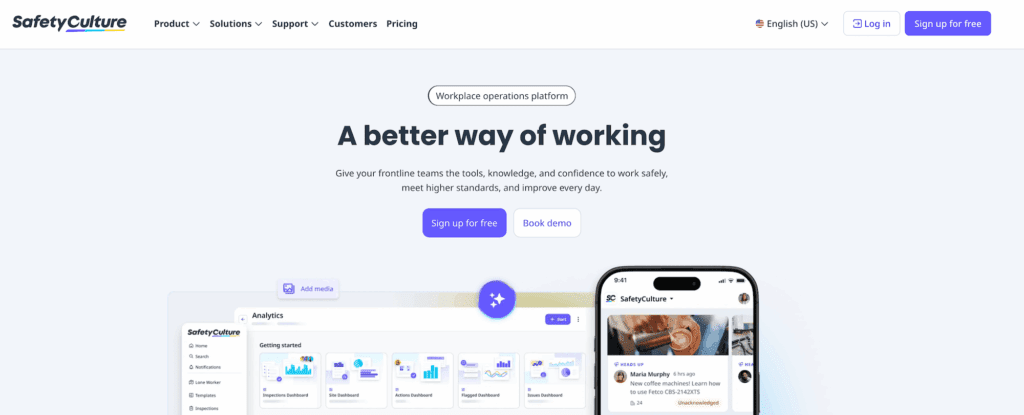
As the name suggests, SafetyCulture is a mobile-first app that helps organizations build safe, compliant workplaces. The app digitizes standard assessments, training courses, and related documentation, such as SOPs and inspection checklists. SafetyCulture also includes:
- Internal communication and collaboration features, including secure real-time messaging and group chats, emergency alerts and incident notifications, and a Heads Up newsfeed for instantly broadcasting safety messages with read receipts and acknowledgments.
- A digital asset register to track non-saleable inventory and ensure safety and regulatory compliance. The asset register allows you to track all your inventory in one place and link QR codes or NFC tags to assets for inspections, incident reporting, and quick access to related information. SafetyCulture also lets you create asset safety checklists, develop maintenance programs, and track the location, status, and usage of your assets via telematics.
- Frontline training tailored to specific roles, teams, departments, and locations. SafetyCulture’s LMS uses generative AI to help you quickly create courses and includes detailed participation metrics for tracking your team’s progress. The app also makes your courses readily available to frontline workers via SMS text, WhatsApp, Slack, Microsoft Teams, QR code, and more options.
3. Totara
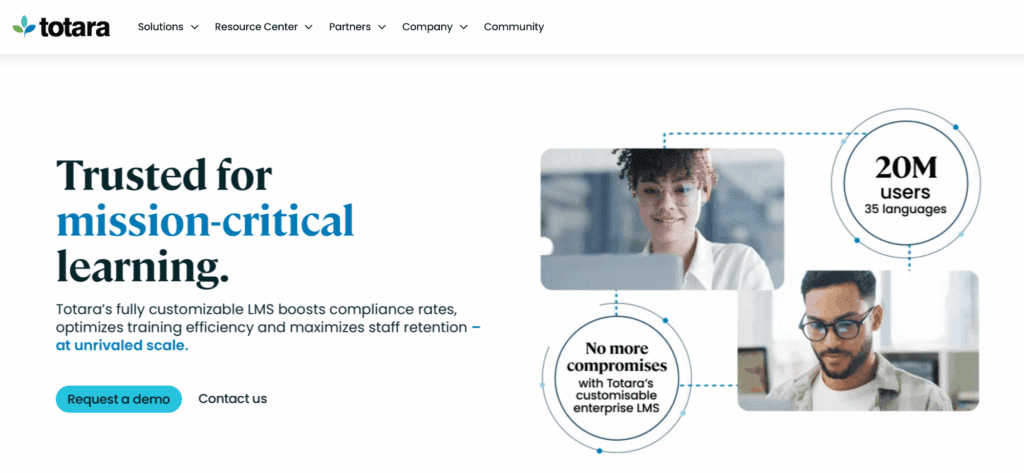
Totara is a highly customizable learning management system (LMS) for the retail sector and other industries, with detailed reporting features. It helps retail businesses reduce turnover by supporting frontline workers—including managers—with tailored, app-based learning experiences. You can use Totara to:
- Create learning paths for new hires to improve onboarding and retention.
- Support ambitious team members with courses for skills development, helping them grow into new roles.
- Provide organization-wide compliance training, with competency frameworks, tailored course sets, and spaced learning.
- Manage performance and coach employees.
Totara’s reporting features provide insights into your program’s overall performance, as well as course-specific information to track learner activity and progress.
4. Beekeeper

Beekeeper is an employee communication and engagement app designed for frontline teams. The platform focuses on making knowledge sharing and management quick and painless for busy, on-the-go teams. Retailer teams can use the mobile-first Beekeeper app to:
- Simplify communications. Beekeeper’s secure messaging app replaces SMS and WhatsApp, allowing employees to communicate across all devices through voice messaging, direct messages, and group chats. Teams can also send out broadcast messages and real-time updates, with support for over 200 languages.
- Support frontline workers with quick answers to knowledge-base questions. Beekeeper centralizes all your knowledge resources and documentation, bringing vital information about schedules, onboarding, PTO requests, training, and payroll to frontline teams in just a few clicks. Beekeeper also provides payroll summaries, reducing related inquiries.
- Manage shifts right from their mobile device. Workers can check, swap, and take on shifts, while administrators can update schedules and create new shifts.
- Increase employee referrals. Workers are notified about new job openings in the Beekeeper app, and they can refer candidates for the role.
5. Kenjo
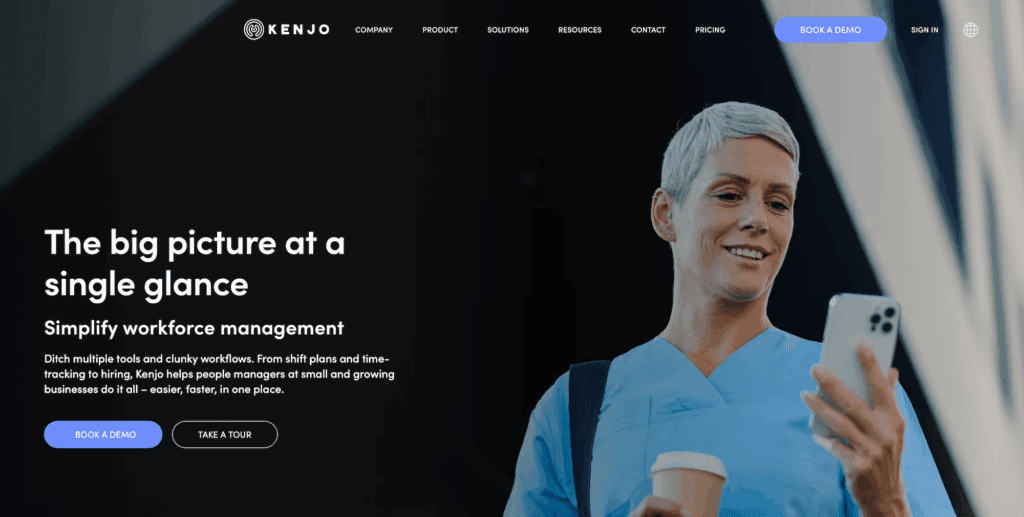
Kenjo is a workforce management system designed to help frontline managers track time, plan and schedule shifts, recruit and onboard new employees, automate HR tasks, and manage employee performance in a single, integrated platform. Here’s a detailed overview of how Kenjo supports retail teams:
- Shift scheduling and management: Managers can create and manage digital shift plans, and view plans by day, month, and week. They can allocate shifts with just one click, manage time off and sick days, oversee PTO requests and overtime, and modify schedules to include absences. Frontline workers can use Kenjo’s mobile app to check their schedules and share feedback.
- Time tracking: Kenjo simplifies time tracking for both regular workers and managers. Employees can manage and update their timesheets from desktop, mobile, or tablet devices, and check in and out using either a QR code or PIN. Managers and admins can:
- Set and adjust working hours, rates, and overtime.
- Calculate salaries on an hourly, weekly, and monthly basis.
- Define fixed legal breaks and overtime hours.
- Approve timesheets from any device with just one click.
- Recruitment and onboarding: HR managers can use Kenjo to create branded job pages and publish listings across platforms (LinkedIn, AngelList, StackOverflow, and many more). The app’s applicant tracking system stores all candidate information in one place, allows you to create ‘talent pools’ for future openings, and automatically saves interview notes.
- People and HR operations analytics. Kenjo’s analytics dashboards help you track new hires and resignations, average salaries, holidays versus sick days, and provide precise insights, such as gender pay gap analysis.
Manage Retail Employee Engagement From End-to-End with Terryberry’s Centralized Platform
Terryberry offers employee listening, recognition, rewards, and wellness tools in a single, integrated platform. Retail organizations, including major chains like the Co-op, use Terryberry to:
- Benchmark employee engagement within their organization, identify gaps, and determine their root causes.
- Take action with engagement programs tailored to their strategic objectives, such as reducing new hire turnover or improving workplace safety.
- Build a business case for their program by demonstrating its impact on engagement and retention, with real numbers.
Ready to boost engagement and retention? Request a live demo of Terryberry today.
